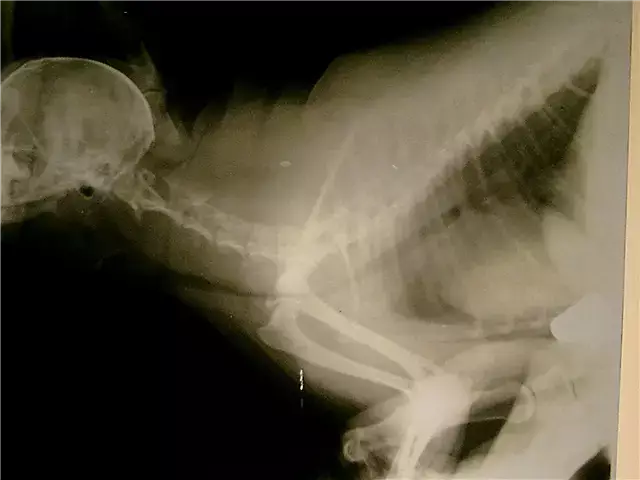- Author Rachel Wainwright [email protected].
- Public 2023-12-15 07:39.
- Last modified 2025-11-02 20:14.
Guthron
Instructions for use:
- 1. Release form and composition
- 2. Indications for use
- 3. Contraindications
- 4. Method of application and dosage
- 5. Side effects
- 6. Special instructions
- 7. Drug interactions
- 8. Analogs
- 9. Terms and conditions of storage
- 10. Terms of dispensing from pharmacies

Gutron is an alpha-adrenergic agonist with a vasoconstrictor, hypertensive effect, has a selective stimulating effect on peripheral alpha-adrenergic receptors.
Release form and composition
Dosage forms:
- tablets (10 pcs. in a blister, 2 blisters in a cardboard box);
- drops for oral administration 1% (10, 20 or 25 ml in a glass bottle of dark color, 1 bottle in a box).
The active ingredient of the tablets is midodrine hydrochloride, in 1 tablet its content is 2.5 mg or 5 mg.
1 ml (30 drops) drops contain:
- active substance: midodrina hydrochloride - 10 mg;
- auxiliary component: ethyl alcohol - 120 mg.
Indications for use
- hypotension, including symptomatic - after surgery and childbirth, or arising while taking psychotropic drugs;
- orthostatic hypotension (idiopathic and secondary, as well as in patients with impaired regulation of blood circulation and circulatory dysregulations, reactions of the type of asympathicotonia and sympathicotonia);
- hypotonic reactions in patients with a predisposition to low blood pressure (BP), against the background of changes in the weather or in the morning;
- spontaneous urination in violation of the function of the sphincter of the bladder.
Contraindications
- arterial hypertension;
- angle-closure glaucoma;
- pheochromocytoma;
- hyperthyroidism;
- severe renal failure;
- acute nephritis;
- mechanical obstruction of the urinary tract;
- adenoma of the prostate gland with residual urine;
- hypersensitivity to midodrine.
Method of administration and dosage
Pills
The tablets are taken orally.
The doctor prescribes the dose individually, depending on the clinical indications and the patient's age.
For children under 12 years of age, the dose is determined by calculation, taking into account the weight of the child.
Recommended dosage for patients over 12 years of age:
- monotherapy: 2.5 mg 2 times (morning and evening) or in the absence of the desired therapeutic effect 3 times a day. If necessary, it is possible to prescribe the drug in a dose of 1.25 mg 2 times a day;
- combination therapy with sedatives or hypnotics: the initial dose is 2.5 mg 2 times a day, then, if necessary, the dose can be increased to 5 mg 2-3 times a day.
Oral drops 1%
Drops are taken orally on a piece of sugar or diluted with a little water. Recommended dosage for patients over 12 years old:
- monotherapy: usually - 7 drops 2 times a day (morning and evening), with a significant effect of the indicated dose, it can be reduced to 3 drops. To achieve a stable clinical state, in rare cases, an increase in the frequency of administration is shown up to three times a day;
- combination therapy with hypnotics or sedatives: 7 drops 2 times a day or 15 drops 2-3 times a day.
For children under 12 years of age, the dose is prescribed depending on body weight.
Side effects
- on the part of the cardiovascular system: pain in the region of the heart, irregular heart rhythm;
- allergic reactions: skin rash.
special instructions
Allowed to use during pregnancy and lactation after prior consultation with a doctor.
Mandatory correction of the dosage regimen is required for patients with severe lesions of the cardiovascular system of an organic nature, disorders of the heart rhythm, and renal function.
It is necessary to carefully select the dose for the treatment of hypotension against the background of changes in the weather, with an indication of a history of hypertension.
Long-term use of Gutron must be accompanied by monitoring of renal function. In addition, a study of renal function should be carried out at the end of an intensive course of therapy.
Drug interactions
With the simultaneous use of Gutron:
- cardiac glycosides can contribute to the development of reflex bradycardia, impaired intracardiac conduction;
- alpha-blockers (phentolamine, prazosin, reserpine) partially or completely reduce the effect of midodrine;
- atropine, cortisone can increase the hypertensive effect.
Analogs
There is no information on analogues.
Terms and conditions of storage
Keep out of the reach of children.
Store at temperatures up to 25 ° C in a dark place.
Shelf life: tablets - 2 years, drops - 3 years.
Terms of dispensing from pharmacies
There is no data.
Information about the drug is generalized, provided for informational purposes only and does not replace the official instructions. Self-medication is hazardous to health!






